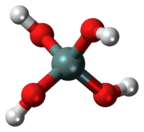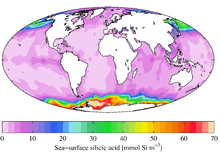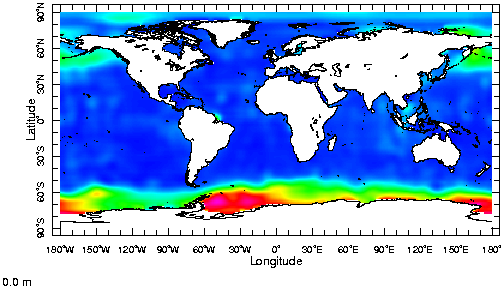Silicic acid
| | |
| Names | |
|---|---|
| IUPAC name
Silicic acid | |
| Other names
Monosilicic acid Orthosilicic acid | |
| Identifiers | |
| 10193-36-9 | |
| 3D model (Jmol) | Interactive image |
| ChEBI | CHEBI:26675 |
| ChemSpider | 14236 |
| ECHA InfoCard | 100.109.340 |
| EC Number | 233-477-0 |
| 2009 | |
| PubChem | 14942 |
| UNII | 623B93YABH |
| |
| |
| Properties | |
| H4O4Si | |
| Molar mass | 96.11 g·mol−1 |
| Acidity (pKa) | 9.84, 13.2 |
| Related compounds | |
| Related compounds |
Orthocarbonic acid |
| Except where otherwise noted, data are given for materials in their standard state (at 25 °C [77 °F], 100 kPa). | |
| | |
| Infobox references | |
Silicic acid /sɪˈlɪsɪk ˌæsɪd/ is a chemical compound. Silicic acid is the general name for a family of chemical compounds containing the element silicon attached to oxide and hydroxyl groups. This family of compounds have the general formula [SiOx(OH)4-2x]n.[1][2] Some simple silicic acids have been identified, but only in very dilute aqueous solution, such as metasilicic acid (H2SiO3), orthosilicic acid (H4SiO4, pKa1=9.84, pKa2=13.2 at 25 °C), disilicic acid (H2Si2O5), and pyrosilicic acid (H6Si2O7); however in the solid state these probably condense to form polymeric silicic acids of complex structure.




Chemical reactions
In general, silicic acid reactions are difficult to control. Partial dehydration to metasilicic acid, for example, is challenging because the reaction typically progresses all the way to silicon dioxide and water.
Acid-base reactions
Like other silanols, silicic acid is a weak acid. It can be deprotonated in solution, the conjugate base silicate is known.
Production
Silicic acid was discovered by Jöns Jacob Berzelius between 1810 and 1836 when studying silicon generated by his experiments. However, he failed to recognise it as distinct from silicon dioxide.
Hydration
Naturally occurring silicic acid is produced by a non-biological process called hydration involving water, and quartz, which is known to be common on Earth. The reaction producing silicic acid from quartz can be written as:
- + → . If the products are left in air dry products are formed.
Laboratory synthesis
Silicic acid can be produced by the acidification of sodium silicate in aqueous solution. The main problem in using silicic acids in chemical synthesis is that silicic acids readily lose water to form randomly polymeric silica gel, a form of silicon dioxide. Such conversion involve condensations.
Oceanic silicic acid

Dissolved silica (DSi) is a term used in the field of oceanography to describe the form of water-soluble silica as silicon hydroxide which can be measured by standard analyses (e.g. Strickland and Parsons, 1972). However, the term dissolved silica excludes silicate occurring as silicate minerals, which is a class of minerals forming rings, sheets, chains, and tetrahedrons. Likewise, the term dissolved silica is different from the term silicone, which is organic polymers of silicon. There exist three different species of DSi in natural waters:
- SiO2(OH)22−
- SiO(OH)3−
- Si(OH)4
DSi (in this context silicic acid) is created near the ocean's surface, by the process of hydration. It is carried into the abyssopelagic zone by falling water in the poles. Uncontrolled build-up of silicic acid in the ocean is naturally checked – although human influence can upset this natural regulation. It is primarily removed by conversion to silicon dioxide and water. In the oceans, silicon exists primarily as orthosilicic acid (H4SiO4), and its biogeochemical cycle is regulated by the group of algae known as the diatoms.[4][5] These algae polymerise the silicic acid to so-called biogenic silica, used to construct their cell walls (called frustules).
Marine diatoms transport Si(OH)4.[6]
In the uppermost water column the surface ocean is undersaturated with respect to DSi, except for the Antarctic Circumpolar Current south of 55°S.

DSi is regenerated with increasing water depth, and DSi values increase along the conveyor belt from the Atlantic over the Indian into the Pacific Ocean.[7][8]


Silicic acid in health
Continuing research of the correlation of aluminium and Alzheimer's disease has in the last few years included the use of silicic acid in beverages,[9][10][11] due to its abilities to both reduce aluminium uptake in the digestive system as well as cause renal excretion of aluminium.
Study has shown that physiological concentration of orthosilicic acid stimulates collagen type 1 synthesis and osteoblastic differentiation in human osteoblast-like cells in vitro.[12]
Choline-stabilized orthosilicic acid is a bioavailable nutritional supplement. It has been shown to prevent the loss of hair tensile strength,[13] have positive effect on skin surface and skin mechanical properties, and on brittleness of hair and nails,[14] abate brittle nail syndrome,[15] partially prevent femoral bone loss in the aged ovariectomized rat model,[16] increase collagen concentration in calves,[17] and have potential beneficial effect on bone collagen formation in osteopenic females.[18]
References
- ↑ N. N. Greenwood, A. Earnshaw, Chemistry of the Elements, 2nd ed., Butterworth-Heinemann, Oxford, UK, 1997.
- ↑ R. K. Iler, The Chemistry of Silica, Wiley, New York, 1979.
- ↑ http://www.nodc.noaa.gov/OC5/WOA09/pr_woa09.html
- ↑ Siever, R. (1991). Silica in the oceans: biological-geological interplay. In: Schneider, S. H., Boston, P. H. (eds.), Scientists On Gaia, The MIT Press, Cambridge MA, USA, pp. 287-295.
- ↑ Treguer, P., Nelson, D. M., Van Bennekom, A. J., DeMaster, D. J., Leynaert, A. and Queguiner, B. (1995). The silica balance in the world ocean: A reestimate. Science 268, 375-379.
- ↑ Del Amo, Y., and M. A. Brzezinski. 1999. The chemical form of dissolved Si taken up by marine diatoms. J. Phycol. 35:1162-1170. https://onlinelibrary.wiley.com/doi/10.1046/j.1529-8817.1999.3561162.x/abstract
- ↑ The figures here have been drawn using the interactive web site which feeds on annual DSi values from LEVITUS94: World Ocean Atlas 1994, an atlas of objectively analyzed fields of major ocean parameters at the annual, seasonal, and monthly time scales. Superseded by WOA98. Edited by Syd Levitus.
- ↑ "World Ocean Atlas 1994".
- ↑ Exley C, Korchazhkina O, Job D, Strekopytov S, Polwart A, Crome P (2006). "Non-invasive therapy to reduce the body burden of aluminium in Alzheimer's disease". J. Alzheimers Dis. 10 (1): 17–24; discussion 29–31. PMID 16988476.
- ↑ González-Muñoz MJ, Peña A, Meseguer I (2008). "Role of beer as a possible protective factor in preventing Alzheimer's disease". Food Chem. Toxicol. 46 (1): 49–56. doi:10.1016/j.fct.2007.06.036. PMID 17697731.
- ↑ Gonzalez-Muñoz MJ, Meseguer I, Sanchez-Reus MI, et al. (2008). "Beer consumption reduces cerebral oxidation caused by aluminum toxicity by normalizing gene expression of tumor necrotic factor alpha and several antioxidant enzymes". Food Chem. Toxicol. 46 (3): 1111–8. doi:10.1016/j.fct.2007.11.006. PMID 18096288.
- ↑ Reffitt DM, Ogston N, Jugdaohsingh R, et al. (2003). "Orthosilicic acid stimulates collagen type 1 synthesis and osteoblastic differentiation in human osteoblast-like cells in vitro". Bone. 32 (2): 127–35. doi:10.1016/S8756-3282(02)00950-X. PMID 12633784.
- ↑ Wickett RR, Kossmann E, Barel A, et al. (2007). "Effect of oral intake of choline-stabilized orthosilicic acid on hair tensile strength and morphology in women with fine hair". Arch. Dermatol. Res. 299 (10): 499–505. doi:10.1007/s00403-007-0796-z. PMID 17960402.
- ↑ Barel A, Calomme M, Timchenko A, et al. (2005). "Effect of oral intake of choline-stabilized orthosilicic acid on skin, nails and hair in women with photodamaged skin". Arch. Dermatol. Res. 297 (4): 147–53. doi:10.1007/s00403-005-0584-6. PMID 16205932.
- ↑ Scheinfeld N, Dahdah MJ, Scher R (2007). "Vitamins and minerals: their role in nail health and disease". J Drugs Dermatol. 6 (8): 782–7. PMID 17763607.
- ↑ Calomme M, Geusens P, Demeester N, et al. (2006). "Partial prevention of long-term femoral bone loss in aged ovariectomized rats supplemented with choline-stabilized orthosilicic acid". Calcif. Tissue Int. 78 (4): 227–32. doi:10.1007/s00223-005-0288-0. PMID 16604283.
- ↑ Calomme MR, Vanden Berghe DA (1997). "Supplementation of calves with stabilized orthosilicic acid. Effect on the Si, Ca, Mg, and P concentrations in serum and the collagen concentration in skin and cartilage". Biol Trace Elem Res. 56 (2): 153–65. doi:10.1007/BF02785389. PMID 9164661.
- ↑ Spector TD, Calomme MR, Anderson SH, et al. (2008). "Choline-stabilized orthosilicic acid supplementation as an adjunct to Calcium/Vitamin D3 stimulates markers of bone formation in osteopenic females: a randomized, placebo-controlled trial". BMC Musculoskelet Disord. 9: 85. doi:10.1186/1471-2474-9-85. PMC 2442067
 . PMID 18547426.
. PMID 18547426.